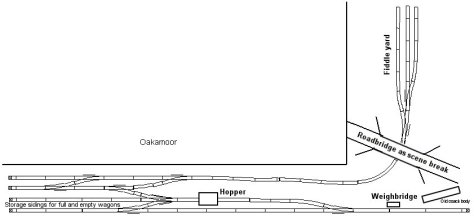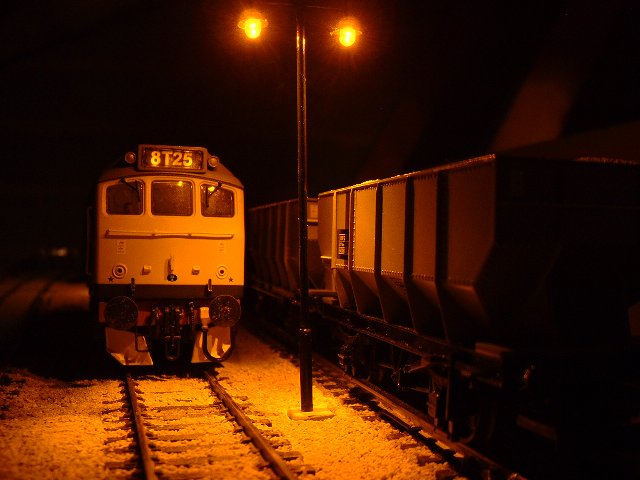OO DCC – Oakamoor.
Fiction :
Set somewhere in the depths of North Staffordshire’s Midland region of BR lies a small branch line ending in sandy sidings where trains regularly come and go, bringing empty wagons and taking away sanrd to be made into glass. A loading hopper of the Hepstones Mineral Company (Later BIS) is connected to the nearby Moneysworth quarry, stands tall in the sidings with a small shunting loco pushing and pulling the wagons beneath it.
A class 25 arrives on the branch with more empties, arriving down the very steep decent into the sidings, from the mainline junction, a short trip up the double track branch. As it draws to a halt, the Class 02 or Class 07 (whichever is at work today) stands ready, the train loco moving out of the loop to the head shunt ready for the yard loco to push the empties back, dragging them into the sidings, before they are moved under the hopper where the loading of the sand commences. Once complete, weighing takes place on the weighbridge near the shed at the bottom of the yard and then they’re taken back into the sidings awaiting collection. Being uncovered, the sand blows everywhere as it dries out, the track soon becoming buried under the white powder like sand giving the yard the look of Blackpool beach and tower. Another load of empties arrive down the bank and the process begins again, with the large loco leaving with a fully laden train.
Reality :
The layout, which is OO gauge, is loosely based on the real Oakamoor at the southern end of the Churnet Valley Railway (a heritage railway) in North Staffordshire where the loading and conveying of silica sand for glass making in the North West of England took place till the end of the 1980s (Now closed in the mid 2010’s, it was all road hauled by Hepworths Mineral Company, Later WBB Minerals from the Moneystone Quarry, not Hepstones and Moneysworth as above ! ). The line ran with a variety of mineral wagons and hopper wagons until the final air braked “PAA” covered hoppers were introduced by BIS in the mid 1980s.
We are predominantly modelling this period, although earlier and later periods can be depicted. Control is Digital (DCC) using the ZTC 511 controller. This gives a good control over the sound and light functions and smooth driving of the Bachmann and Hornby locos at the head of the trains.
The layout does bare a resemblance to the real yard, including the hopper, weighbridge and engine shed, but due to space, the main line is the opposite end to reality and the climb out the yard is pure fiction ! The locos are mainly the types that would have worked the freight from the yard, but with the preserved numbers now seen working on the CVR, with the odd visitor.
The fitting of lights in the locos and the yard make it quite a joy to work at night, with the class 24 featuring sound and the hopper really loading sand into the empty wagons below, this layout is appealing to all ages. Measuring 9ft x 6ft, it fits easily into the back of a small family car and is two person operated. Most locos, unless in a company livery are in BR blue, but with a variety of D nos or Tops code.
Built more as a side entertainment at model exhibitions, there won’t be much variety of stock I’m afraid, but it is DCC controlled. No sectioning here, so two locos can easily move on one track at any time. Look out for the CCTV inside the hopper so you can watch the wagons being loaded, just like you were in the control cabin on the side.
Locos to be seen :
Class 02 (Cammell) Class 07 (former 07 003 In BIS livery) Class 08 (D3881)
Class 20 (D8154) Class 24 (24 081) Class 25 (25 322)
Class 31 (31270) Class 37 (37424) & Class 47 (47524).
(There may also be the chance of a DMU on a charter or Steam hauled freight from the yard.)
First exhibition – Warwick April 2005. Stored 2008 -2016 (resurrected after a house move)
More to follow as it develops.. Andy
Photos from the early days in 2005.

Track Diagram
Pre first exhibition in 2005 and at the first exhibition.
Tonbridge and West Sussex exhibitions. 2006 & 2007.


































